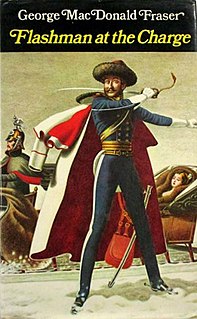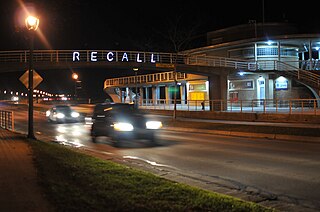
The Battle of Balaclava, fought on 25 October 1854 during the Crimean War, was part of the Siege of Sevastopol (1854–55), an Allied attempt to capture the port and fortress of Sevastopol, Russia's principal naval base on the Black Sea. The engagement followed the earlier Allied victory in September at the Battle of the Alma, where the Russian General Menshikov had positioned his army in an attempt to stop the Allies progressing south towards their strategic goal. Alma was the first major encounter fought in the Crimean Peninsula since the Allied landings at Kalamita Bay on 14 September, and was a clear battlefield success; but a tardy pursuit by the Allies failed to gain a decisive victory, allowing the Russians to regroup, recover and prepare their defence.
Foreign Legion most often refers to:

The Thin Red Line was an episode in the Battle of Balaclava on 25 October 1854, during the Crimean War. In the incident, around 500 men of the 93rd, aided by a small force of 100 walking wounded, 40 detached Guardsmen, and supported by a substantial force of Turkish infantrymen, led by Sir Colin Campbell, fired at the Russian cavalry. Previously, Campbell's Highland Brigade had taken part in actions at the Battle of Alma and the Siege of Sevastopol. There were more Victoria Crosses presented to the Highland soldiers at that time than at any other. The event was lionised in the British press and became an icon of the qualities of the British soldier in a war that was arguably poorly managed and increasingly unpopular.

The Battle of Beersheba was fought on 31 October 1917, when the British Empire's Egyptian Expeditionary Force (EEF) attacked and captured the Yildirim Army Group garrison at Beersheba, beginning the Southern Palestine Offensive of the Sinai and Palestine campaign of World War I. Infantry from the 60th (London) and the 74th (Yeomanry) Divisions of the XX Corps from the southwest conducted limited attacks in the morning, then the Anzac Mounted Division launched a series of attacks against the strong defences which dominated the eastern side of Beersheba, resulting in their capture during the late afternoon. Shortly afterwards, the Australian Mounted Division's 4th and 12th Light Horse Regiments conducted a mounted infantry charge with bayonets in their hands, their only weapon for mounted attack, as their rifles were slung across their backs. Part of the two regiments dismounted to attack entrenchments on Tel es Saba defending Beersheba while the remainder of the light horsemen continued their charge into the town, capturing the place and part of the garrison as it was withdrawing.

"The Charge of the Light Brigade" is an 1854 narrative poem by Alfred, Lord Tennyson about the Charge of the Light Brigade at the Battle of Balaclava during the Crimean War. He wrote the original version on 2 December 1854, and it was published on 9 December 1854 in The Examiner. He was the Poet Laureate of the United Kingdom at the time. The poem was subsequently revised and expanded for inclusion in Maud and Other Poems (1855).
Valley of Death may refer to:
"The Last of the Light Brigade" is a poem written in 1890 by Rudyard Kipling echoing – thirty-six years after the event – Alfred Tennyson's famous poem The Charge of the Light Brigade. Employing synecdoche, Kipling uses his poem to expose the terrible hardship faced in old age by veterans of the Crimean War, as exemplified by the cavalry men of the light brigade who charged at the Battle of Balaclava. It describes a visit by the last twenty survivors of the charge to Tennyson to reproach him gently for not writing a sequel about the way in which England was treating its old soldiers. Some sources treat the poem as an account of a real event, but other commentators class the destitute old soldiers as allegorical, with the visit invented by Kipling to draw attention to the poverty in which the real survivors were living, in the same way that he evoked Tommy Atkins in "The Absent Minded Beggar".

Flashman at the Charge is a 1973 novel by George MacDonald Fraser. It is the fourth of the Flashman novels. Playboy magazine serialised Flashman at the Charge in 1973 in their April, May and June issues. The serialisation is unabridged, including most of the notes and appendixes and features a few illustrations, collages from various paintings and pictures to depict a period montage of the Charge and Crimea.

The Charge of the Light Brigade is a 1968 British DeLuxe Color war film made by Woodfall Film Productions and distributed by United Artists, depicting parts of the Crimean War and the eponymous charge. It was directed by Tony Richardson and produced by Neil Hartley. Its animated credits and linking passages were created by Richard Williams, drawing on the satirical use of Victorian-era jingoistic images. This film features Richardson's daughters Natasha and Joely in their debuts.

The Charge of the Light Brigade is a 1936 American historical adventure film from Warner Bros., starring Errol Flynn and Olivia de Havilland. It was directed by Michael Curtiz and produced by Samuel Bischoff, with Hal B. Wallis as the executive producer. The film's screenplay is by Michael Jacoby and Rowland Leigh, from a story by Michael Jacoby, and based on the 1854 poem "The Charge of the Light Brigade" by Alfred, Lord Tennyson. The music score was composed by Max Steiner, his first for Warner Bros., and the cinematography was by Sol Polito. Scenes were shot at the following California locations: Lone Pine, Sherwood Lake, Lasky Mesa, Chatsworth, and Sonora. The Sierra Nevada mountains were used for the Khyber Pass scenes.

Taxis to Hell – and Back – Into the Jaws of Death is a photograph taken on June 6, 1944, by Robert F. Sargent, a chief photographer's mate in the United States Coast Guard. It depicts soldiers of the U.S. Army's 1st Infantry Division disembarking from an LCVP from the U.S. Coast Guard-crewed USS Samuel Chase at Omaha Beach during the Normandy Landings in World War II.
Lighthorse or Light Horse most often refers to Light cavalry, but may also refer to:

The Charge of the Light Brigade was a failed military action involving the British light cavalry led by Lord Cardigan against Russian forces during the Battle of Balaclava on 25 October 1854 in the Crimean War. Lord Raglan had intended to send the Light Brigade to prevent the Russians from removing captured guns from overrun Turkish positions, a task for which the light cavalry were well-suited. However, there was miscommunication in the chain of command and the Light Brigade was instead sent on a frontal assault against a different artillery battery, one well-prepared with excellent fields of defensive fire. The Light Brigade reached the battery under withering direct fire and scattered some of the gunners, but they were forced to retreat immediately, and the assault ended with very high British casualties and no decisive gains.

The Long Day's Dying is a 1968 British Techniscope war film directed by Peter Collinson based on the 1962 novel of the same name by Alan White and starring David Hemmings. It was listed to compete at the 1968 Cannes Film Festival, but the festival was cancelled due to the events of May 1968 in France. The film was then able to compete at the 1968 San Sebastián International Film Festival, where it won its top prize, the Golden Shell for Best Film.

The Charge of the Light Brigade is a 1912 American silent historical drama film directed by J. Searle Dawley. Produced by Edison Studios, the film portrays the disastrous yet inspiring military attack in October 1854 by British light cavalry against Russian artillery positions in the Battle of Balaclava during the Crimean War. Director Dawley also wrote the scenario for this production, adapting it in part from the famous 1854 narrative poem about the charge by British poet laureate Alfred, Lord Tennyson, who completed his poem just six weeks after the actual event. The film's action scenes and landscape footage were shot between late August and early September 1912, while Dawley and his company of players and crew were on location in Cheyenne, Wyoming. In order to produce a sizable and believable recreation of the charge, the director needed a very large number of horsemen. Fortunately for Dawley, the commander of United States Army cavalry at Fort D. A. Russell at Cheyenne agreed to provide "about 800" troopers and "their trained mounts" to the Edison project.

Overpass Light Brigade (OLB) is an activist collaborative public art project based in Milwaukee, Wisconsin, and organized by American artists Lane Hall and Lisa Moline and photographer Joe Brusky. The artwork is an episodic performance originally created as part of the 2011 Wisconsin protests to raise awareness about the campaign to recall Governor Scott Walker. OLB was co-founded by Hall and Moline. Brusky, a community organizer and co-founder of Occupy Riverwest, soon joined the project and facilitated its continued growth and social media presence.
The Light Brigade may refer to:
The Reason Why is a 2010 album by Little Big Town










